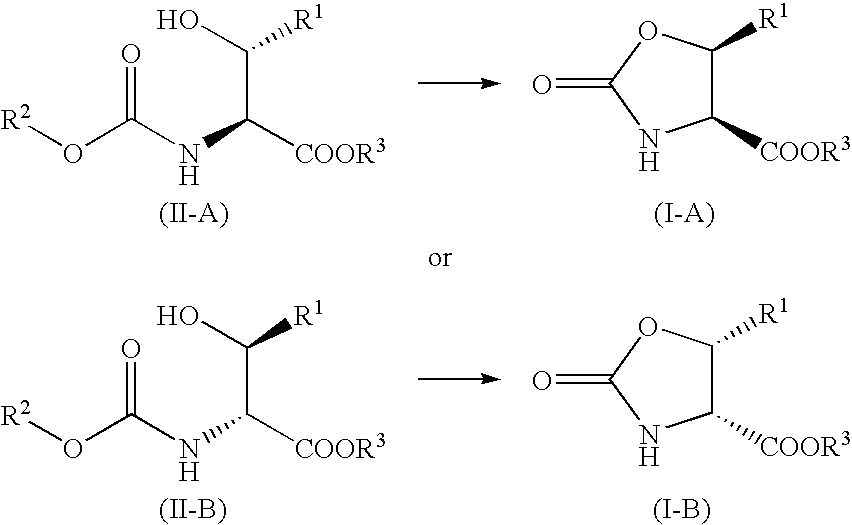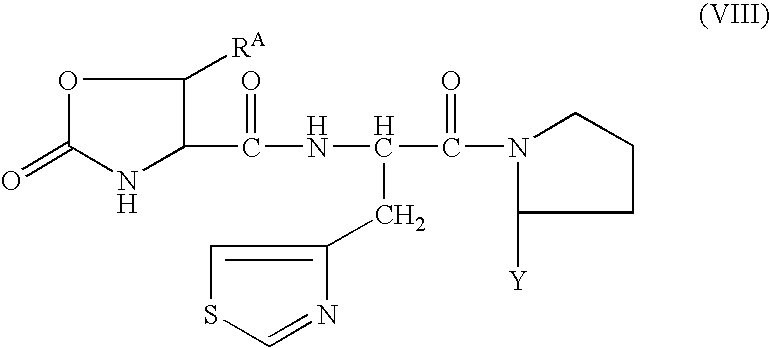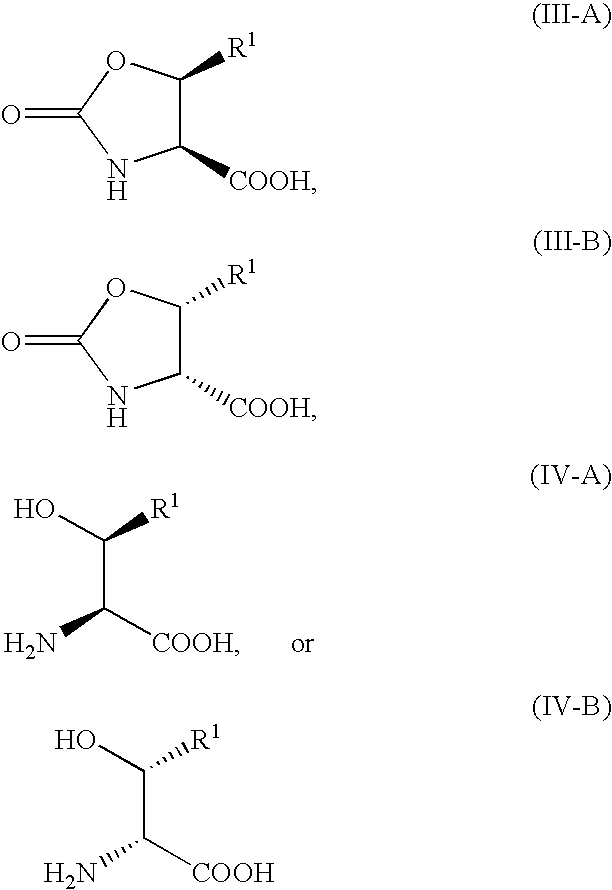Processes for the preparation of oxo-oxazoline or alloamino acid derivatives
a technology of alloamino acid and oxo-oxazoline, which is applied in the preparation of carbamic acid derivatives, organic chemistry, peptides, etc., can solve the problems of toxic to the human body, and achieve the effect of simple, inexpensive and stereoselective manner
- Summary
- Abstract
- Description
- Claims
- Application Information
AI Technical Summary
Benefits of technology
Problems solved by technology
Method used
Image
Examples
example 1
[0094]
[0095]Potassium hydroxide (54.77 g) and a compound (1) (L-threonine) (100.0 g) were dissolved in water (1000 ml). To the solution was added potassium carbonate (139.23 g).
[0096]The resultant solution was cooled below 10° C. Toluene (180 ml) solution of Z—Cl (157.5 g) was dropped into the solution at 10±5° C. for about one hour while the solution was vigorously stirred. The stirring was further continued for about 1.5 hours at the same temperature. Thereafter, the resulting reaction mixture was extracted with toluene (120 ml). The aqueous layer was washed with toluene (200 ml). Each toluene layer was extracted with water (50 ml) again. The aqueous layers were combined. To the resultant aqueous layer was added 25% hydrochloric acid (about 294 g) to adjust the pH to 2.0±0.5, followed by extraction with ethyl acetate (800 ml). The organic layer was washed with 10% brine (400 ml). Each aqueous layer was extracted with ethyl acetate (200 ml) again. Thereafter, the organic layers wer...
example 2
[0099]
[0100]A solution of a compound (3) (50.0 g) and thionyl chloride (24.48 g) in toluene (250 ml) was stirred at 80° C. for 8 hours and thereafter was cooled to room temperature. The reaction mixture was extracted with water (150 ml). The aqueous layer was washed with toluene (25 ml). Each toluene layer was extracted with water (50 ml) again. Thereafter, the aqueous layers were combined. 36% hydrochloric acid (18.94 g) was added to the resultant aqueous layer. The aqueous layer was stirred at 80° C. for one hour and thereafter the water was evaporated. Water (100 ml) was added to the residue, followed by condensation. Adding acetonitrile (200 ml) to the residue and condensing were repeated three times. Acetonitrile was added to adjust the volume to about 50 ml. The resultant slurry was stirred at 0±5° C. for one hour. Thereafter, crystals were collected by filtration and dried. Thus, 17.4 g of compound (5) was obtained (yield 64%).
[0101]Melting point: 165° C.
[0102]1H NMR (CD3OD) ...
example 3
[0103]
[0104]A solution of a compound (3) (3.0 g) and thionyl chloride (1.47 g) in toluene (15 ml) was stirred at 80° C. for 8 hours and thereafter was cooled to room temperature. The reaction mixture was extracted with water (9 ml). The aqueous layer was washed with toluene (1.5 ml). Each toluene layer was extracted with water (3 ml) and water (1.5 ml). The aqueous layers were combined. The resultant aqueous layer was condensed, thereby obtaining 1.48 g of compound (4) as oil (yield 83%).
[0105]1H NMR (CD3OD) δ 1.31 (d, J=6.48, 3H), 3.79 (s, 3H), 4.46 (d, J=8.52, 1H), 4.96 (dq, J=6.48, J=8.52, 1H)
PUM
| Property | Measurement | Unit |
|---|---|---|
| temperature | aaaaa | aaaaa |
| volume | aaaaa | aaaaa |
| temperature | aaaaa | aaaaa |
Abstract
Description
Claims
Application Information
 Login to View More
Login to View More - R&D
- Intellectual Property
- Life Sciences
- Materials
- Tech Scout
- Unparalleled Data Quality
- Higher Quality Content
- 60% Fewer Hallucinations
Browse by: Latest US Patents, China's latest patents, Technical Efficacy Thesaurus, Application Domain, Technology Topic, Popular Technical Reports.
© 2025 PatSnap. All rights reserved.Legal|Privacy policy|Modern Slavery Act Transparency Statement|Sitemap|About US| Contact US: help@patsnap.com



